The .45 ACP is a popular handgun cartridge that needs no introductions whatsoever. Developed in 1904, it is the longest-serving handgun round for the U.S Military and NATO forces, and still dominates a large chunk of the big caliber handgun space.
We will be comparing this legendary, battle-proven cartridge with a newer, but equally formidable cartridge, the 10 mm Auto. A round that was an initial failure, but began picking up traction in the last decade as a bear defense gun.
The comparison of the ballistics and power data for these rounds ended up in an interesting conclusion, and you should also look at it to decide which of these is suitable for your needs.
10mm vs 45 ACP

10mm

45 ACP
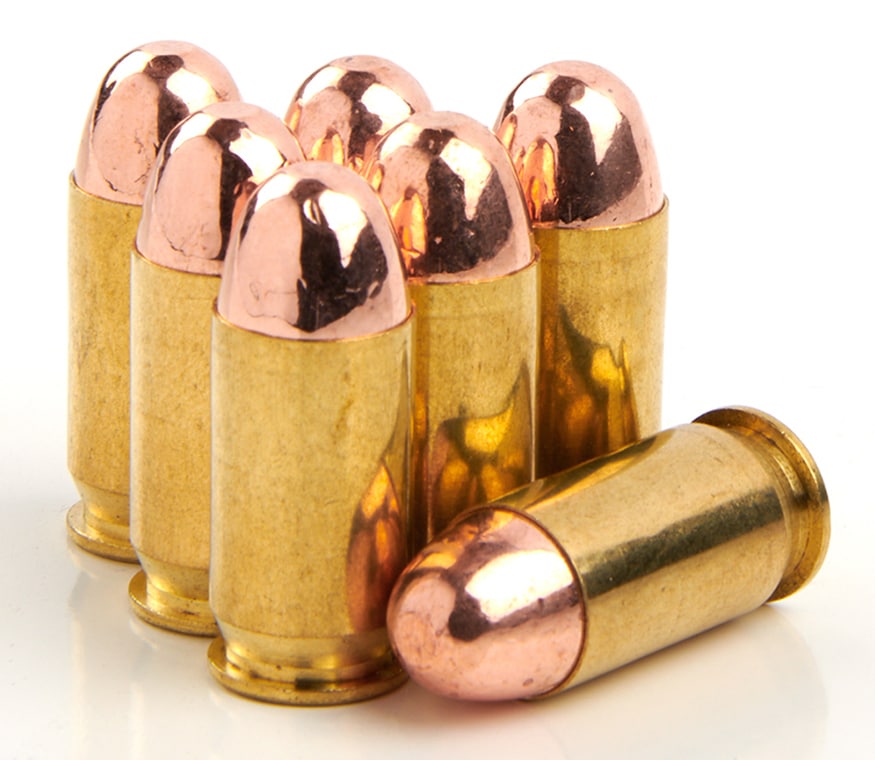
Pros
10mm
Wide range of gun and ammo options
Stays supersonic out to a long distance
High sectional density and ballistic coefficients
Flat trajectory, hard-hitting energy, and momentum
Also available in a shorter version known as the .40 S&W
Widely used as a bear defense round. Also suitable for hunting
45 ACP
Great balance of power and control
Wide range of ammo and firearm options
Reliable and tested big caliber cartridge for more than a century
Served as the sidearm cartridge for the U.S Military for eight decades
Inherently subsonic. Works great with suppressors and causes less wear and tear
Cons
10mm
Ammo is pricey and can be hard to find
Heavy recoil. Requires practice to tame
45 ACP
Recoil can be unsuitable for some users
Does not shoot very flat beyond 50 yards
Best For
10mm
The 10 mm Auto is best for bear defense/hunting, and people who want a powerful round without minding the recoil or mag capacity.
45 ACP
The .45 ACP is a versatile big caliber handgun round suitable for everything from hunting to competitions, but with 40-50 yards.
10mm Overview
The 10 mm Auto, colloquially known as the 10 mm is a .40 caliber round design that became popular due to its adoption by the FBI during the 1980s. It is a rimless, straight-walled, handgun cartridge that was developed by the famous Col. Jeff Cooper with the Dornaus & Dixon Enterprises, Inc. for their Bren Ten pistol. It was later adopted by Norma for production. In the long run, the pistol was an instant failure, and the cartridge failed to impress the masses due to production issues and the price.
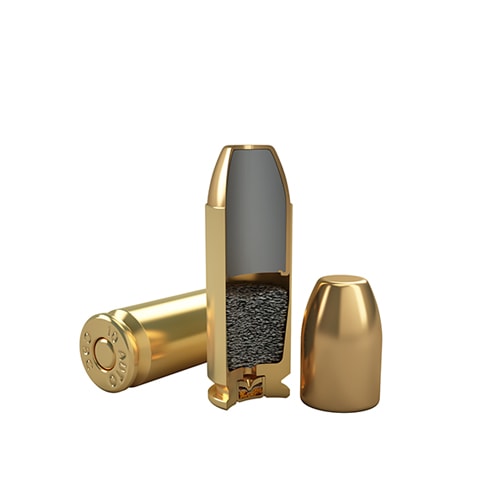
The cartridge was designed in 1983 and was adopted by the FBI after the 1986 FBI Miami shootings because the existing rounds were considered less powerful. However, the adoption of this round was short-lived and was later replaced by the FBI due to training issues arising from the recoil and controllability.
A shorter version of the 10 mm Auto was created, which came to be known as the .40 S&W, and it is still quite popular among LEO’s and the hunting community. It is also one of the most popular bear defense guns on the market today.
45 ACP Overview
The .45 ACP (Automatic Colt Pistol), also known as the .45 Auto is a rimless straight-walled cartridge that is mostly used in handguns. It was designed by the famous firearms inventor John Moses Browning in 1904. Around the same time, the U.S Military was planning to replace the .38 Long Colt and .45 SAA revolvers with a better gun. It was also during this time when the military concluded that .45 caliber was the appropriate caliber for handgun rounds.
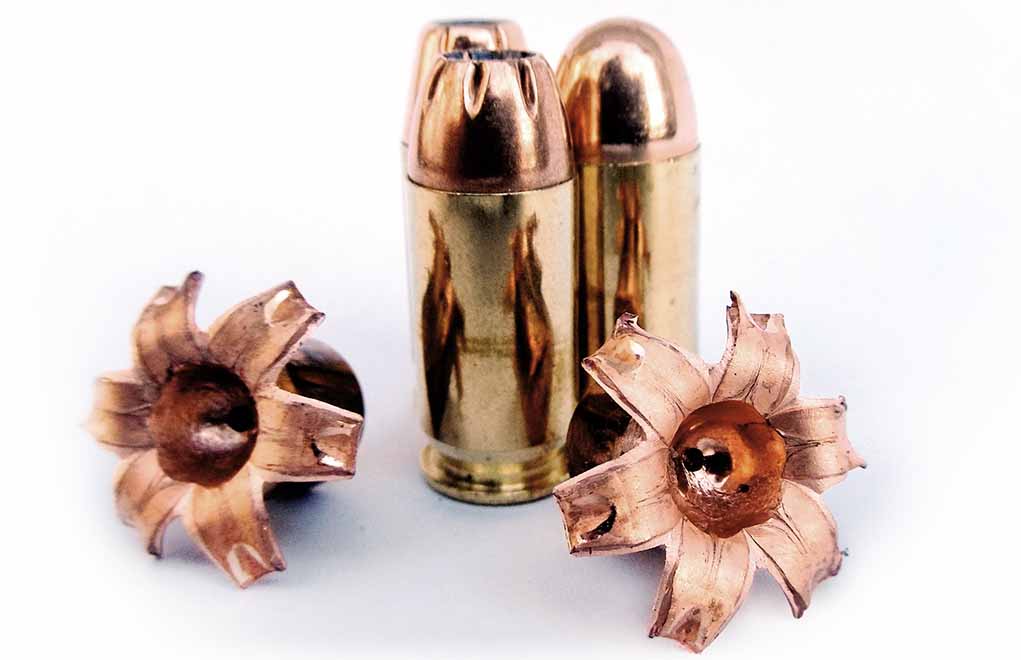
After years of trials and reviews, the military finally adopted the Colt M1911 chambered in .45 Auto as their primary sidearm. This cartridge and handgun served as the primary sidearm for the military until 1985 when it was replaced by the 9 mm.
This round has proven itself over the years as an accurate and effective combat cartridge. While many users have now switched over to the 9 mm for its controllability, the .45 ACP is still widely loved by a large community of people. Especially those who want a big handgun caliber with balanced characteristics.
10mm vs 45 ACP: Cartridge Specs
Here is a quick comparison of the dimensions and other specifications for these cartridges.
 | 10mm | 45 ACP |
|---|---|---|
| Bullet Diameter | .4005 in (10.17 mm) | .450 in (11.4 mm) |
| Neck Diameter | .423 in (10.7 mm) | .473 in (12.0 mm) |
| Base Diameter | .425 in (10.8 mm) | .476 in (12.1 mm) |
| Case Length | .992 in (25.2 mm) | .898 in (22.8 mm) |
| Overall Length | 1.260 in (32.0 mm) | 1.275 in (32.4 mm) |
| Case Capacity | 24.1 grains | 26.7 grains |
| Max Pressure (SAAMI) | 37,500 psi | 21,000 psi |
| Typical Casing Material | Brass | Brass |
| Typical Bullet Weight (gr) | 155-200 grains | 165-230 grains |
The 10 mm Auto uses a .40 caliber bullet, compared to the .45 caliber bullet of the .45 ACP. While the 10 mm is a slimmer cartridge, the .45 ACP is slightly longer in comparison to OAL. So overall, the .45 ACP is a slightly bigger cartridge compared to the 10 mm. This means that handguns for the .45 ACP will be a bit bigger, and have a larger grip swell. Although in terms of mag capacity, both these rounds share equal status. Both these cartridges have the headspace to the rim.
As far as the case capacity is concerned, the .45 ACP has more space by a couple of grains, which is also viable given the weight of bullets. The 10 mm is loaded at a maximum pressure of 37,500 psi, compared to the 21,000 psi of .45 ACP. This ensures that .45 Auto handguns will face lesser wear and tear, and will have a longer service life. Additionally, it also helps with keeping the bullet subsonic.
The bullet weights of both these rounds are comparable, however, the .45 ACP has a higher maximum weight that can go as high as 230 grains.
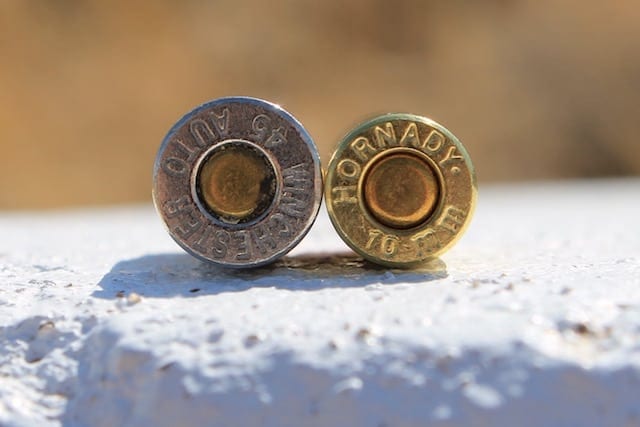
10mm vs 45 ACP: Ballistics
The ballistics of a cartridge measures its performance related to the trajectory, speed, and energy over a given range. These factors are important in understanding the accuracy and power characteristics, which in turn helps estimate the effective range, expected accuracy, and suitability for different types of targets.
The most optimal barrel lengths, and the most common bullet designs and weights have been used to calculate the ballistics data for these rounds.
10mm vs 45 ACP: Trajectory
Here is a quick overview of the trajectory values for these rounds out a distance of 125 yards. Although handguns are not meant to be used for that kind of range, this is just to give you an idea.
10 mm
| 5”barrel/BC 0.14/165 grains Cor-Bon JHP | 5”barrel/BC 0.170/180 grains Hydra-Shok | 5”barrel/BC 0.210/200 grains Fusion Soft Point |
|---|---|---|
| 25 yds: 0 “ Drop | 25 yds: 0 “ Drop | 25 yds: 0 “ Drop |
| 50 yds: 0.10 “ Drop | 50 yds: 0.7 “ Drop | 50 yds: 0.70 “ Drop |
| 75 yds: 1.96 “ Drop | 75 yds: 3.7 “ Drop | 75 yds: 3.2 “ Drop |
| 100 yds: 5.77 “ Drop | 100 yds: 9.1 “ Drop | 100 yds: 7.6 “ Drop |
| 125 yds: 11.68 “ Drop | 125 yds: 17.20 “ Drop | 125 yds: 13.9 “ Drop |
45 ACP
| 5.03” barrel/BC 0.130/165-grain Hydra-Shok | 5.03” barrel/BC 0.070/185-grain FMJ Semi Wadcutter | 5.03” barrel/BC 0.190/230-grain FMJ |
|---|---|---|
| 25 yds: 0 “ Drop | 25 yds: 0 “ Drop | 25 yds: 0 “ Drop |
| 50 yds: 1.2 “ Drop | 50 yds: 3.1 “ Drop | 50 yds: 2 “ Drop |
| 75 yds: 4.7 “ Drop | 75 yds: 10.6 “ Drop | 75 yds: 6.9 “ Drop |
| 100 yds: 10.6 “ Drop | 100 yds: 23 “ Drop | 100 yds: 15 “ Drop |
| 125 yds: 19.1 “ Drop | 125 yds: 40.6 “ Drop | 125 yds: 26.1 “ Drop |
Both these rounds have been zeroed at a distance of 25 yards since that is where most of the action takes place with handguns.
Now, what is clear for the trajectory data is that the 10 mm will always have a flatter trajectory compared to the .45 ACP. A big reason for this is the heavy bullet weight for the .45 ACP, and also that the 10 mm is loaded at higher pressures.
As far as wind resistance is concerned, the 10 mm Auto bullets generally show better ballistic coefficient values. Thus making them comparatively more accurate than the .45 ACP. It is also important to note that different types of bullets show different behaviors. So the trajectory will also depend upon the bullet you choose.
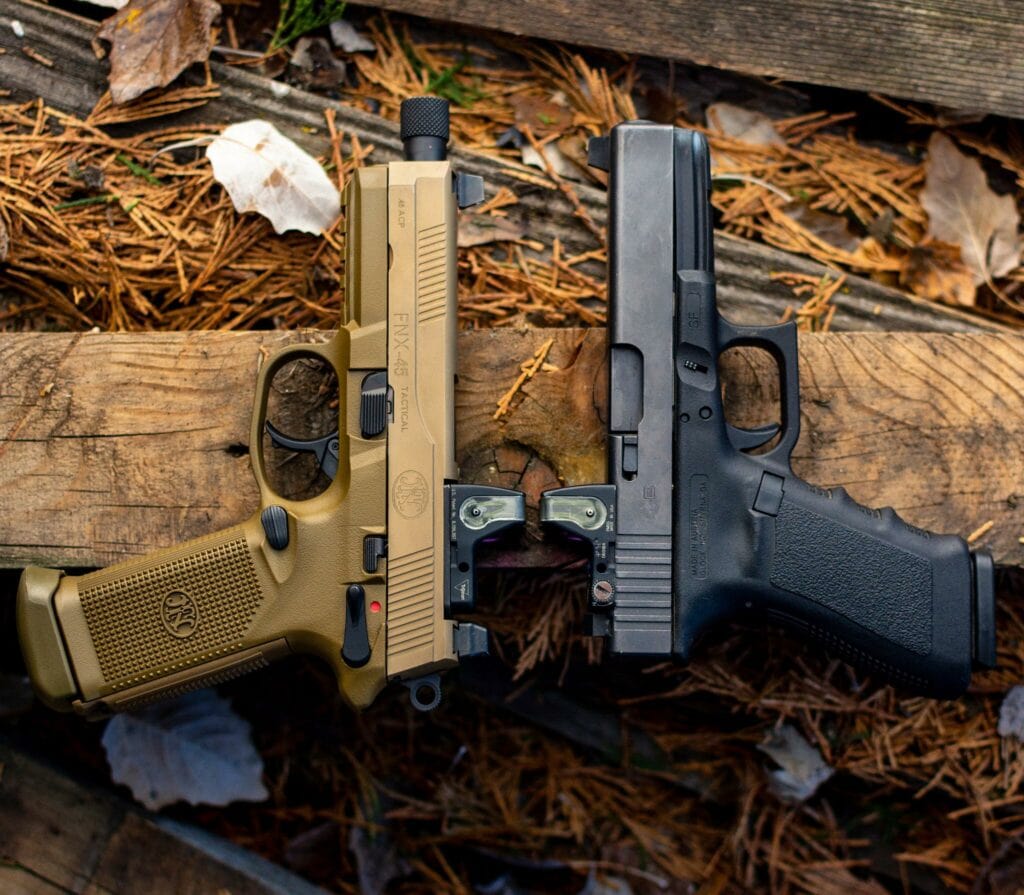
Comparing the data tells us that the 10 mm Auto rounds show a manageable drop out to 75 yards, whereas, the .45 ACP is easier to guess for point of impact within the 50-yard range. The 10 mm also shows a notably flatter trajectory out to 100 yards, considering the weight of the bullets.
The military preaches the maximum effective range of a .45 ACP to be 75 yards, and it is also used by competition shooters for 50-yard events. However, the 10 mm can easily achieve what a .45 ACP can do, when you are shooting at paper targets.
10mm vs 45 ACP: Velocity & Kinetic Energy
A tabular comparison of the velocity and kinetic energy characteristics of the 10 mm Auto vs the .45 ACP.
10 mm
| 5”barrel/BC 0.140/165 grains Cor-Bon JHP | 5”barrel/BC 0.170/180 grains Hydra-Shok | 5”barrel/BC 0.210/200 grains Fusion Soft Point |
|---|---|---|
| 25 yds: 1,173 ft/s, 504 ft.lbs | 25 yds: 998 ft/s, 398 ft.lbs | 25 yds: 1,153 ft/s, 591 ft.lbs |
| 50 yds: 1,110 ft/s, 451 ft.lbs | 50 yds: 970 ft/s, 376 ft.lbs | 50 yds: 1,112 ft/s, 549 ft.lbs |
| 75 yds: 1,058 ft/s, 410 ft.lbs | 75 yds: 945 ft/s, 357 ft.lbs | 75 yds: 1,077 ft/s, 515 ft.lbs |
| 100 yds: 1,015 ft/s, 377 ft.lbs | 100 yds: 921 ft/s, 339 ft.lbs | 100 yds: 1,045 ft/s, 485 ft.lbs |
| 125 yds: 978 ft/s, 350 ft.lbs | 125 yds: 900 ft/s, 323 ft.lbs | 125 yds: 1,017 ft/s, 460 ft.lbs |
45 ACP
| 5.03” barrel/BC 0.130/165 grain Hydra-Shok | 5.03” barrel/BC 0.070/185 grain FMJ Semi Wadcutter | 5.03” barrel/BC 0.190/230 grain FMJ |
|---|---|---|
| 25 yds: 1,014 ft/s, 377 ft.lbs | 25 yds: 735 ft/s, 222 ft.lbs | 25 yds: 844 ft/s, 364 ft.lbs |
| 50 yds: 976 ft/s, 349 ft.lbs | 50 yds: 703 ft/s, 203 ft.lbs | 50 yds: 828 ft/s, 350 ft.lbs |
| 75 yds: 942 ft/s, 325 ft.lbs | 75 yds: 672 ft/s, 185 ft.lbs | 75 yds: 813 ft/s, 338 ft.lbs |
| 100 yds: 912 ft/s, 305 ft.lbs | 100 yds: 642 ft/s, 170 ft.lbs | 100 yds: 799 ft/s, 326 ft.lbs |
| 125 yds: 885 ft/s, 287 ft.lbs | 125 yds: 615 ft/s, 155 ft.lbs | 125 yds: 785 ft/s, 315 ft.lbs |
The 10 mm Auto shows supersonic speeds out to a distance of 75 yards in most cases. The reason is the high chamber pressure that propels the bullet at a faster speed, even with the heavy weight. On the other hand, the .45 ACP is inherently a subsonic cartridge because of its lower chamber pressure and heavier bullets.
However, this subsonic capability of the .45 ACP makes it very suitable for use with suppressors. This round has widely been used for submachine guns like the Thompson back in the day. The subsonic characteristics also mean that the round will exert lesser wear and tear on the internal parts.
The supersonic characteristics of the 10 mm Auto, along with the high chamber pressure will mean lesser life of the handgun. In terms of speed and accuracy, the 10 mm Auto definitely has an edge. However, the .45 ACP can attain similar performance with its +p loads.
Moving on to the energy characteristics, the 10 mm Auto seems to be the clear winner in comparable as well as incomparable bullet weights. The higher velocity definitely contributes to the better energy of the 10 mm Auto and gives it 40-45% more energy than the .45 ACP.

10mm vs 45 ACP: Stopping Power
The stopping power is the ability of a round to incapacitate or immobilize a target. In layman terms, this means how quickly a round can damage or kill a target. For example, if it takes one round of a cartridge to kill a deer rather than two for another cartridge, the former has better stopping power.
To measure this power, the most definitive factors are the sectional density and momentum of a bullet. I have created a table in the upcoming section, which describes these values for these cartridges.
10mm vs 45 ACP: Momentum & Sectional Density
Take a look at this table that elaborates on the momentum values for the 10 mm Auto and .45 ACP rounds at different distances.
10 mm
| 5”barrel/BC 0.140/165 grains Cor-Bon JHP Sectional Density: 0.147 | 5”barrel/BC 0.170/180 grains Hydra-Shok Sectional Density: 0.161 | 5”barrel/BC 0.210/200 grains Fusion Soft Point Sectional Density: 0.179 |
|---|---|---|
| 25 yds: 27- ft.lb-s | 25 yds: 25 ft.lb-s | 25 yds: 32 ft.lb-s |
| 50 yds: 26 ft.lb-s | 50 yds: 24 ft.lb-s | 50 yds: 31 ft.lb-s |
| 75 yds: 24 ft.lb-s | 75 yds: 24 ft.lb-s | 75 yds: 30 ft.lb-s |
| 100 yds: 23 ft.lb-s | 100 yds: 23 ft.lb-s | 100 yds: 29 ft.lb-s |
| 125 yds: 23 ft.lb-s | 125 yds: 23 ft.lb-s | 125 yds: 29 ft.lb-s |
45 ACP
| 5.03” barrel/BC 0.130/165 grain Hydra-Shok Sectional Density: 0.116 | 5.03” barrel/BC 0.070/185 grain FMJ Semi Wadcutter Sectional Density: 0.131 | 5.03” barrel/BC 0.190/230 grain FMJ Sectional Density: 0.162 |
|---|---|---|
| 25 yds: 23 ft.lb-s | 25 yds: 19 ft.lb-s | 25 yds: 27 ft.lb-s |
| 50 yds: 23 ft.lb-s | 50 yds: 18 ft.lb-s | 50 yds: 27 ft.lb-s |
| 75 yds: 22 ft.lb-s | 75 yds: 17 ft.lb-s | 75 yds: 26 ft.lb-s |
| 100 yds: 21 ft.lb-s | 100 yds: 16 ft.lb-s | 100 yds: 26 ft.lb-s |
| 125 yds: 20 ft.lb-s | 125 yds: 16 ft.lb-s | 125 yds: 25 ft.lb-s |
The sectional density (SD) of a bullet is the ratio of the mass of a bullet to its cross-sectional area. It is known that bullets with a higher value of SD deliver deeper penetration, compared to those with a lower SD. A range of SD values has also been established which elaborates on what value of SD is suitable for hunting small, medium, or big sized game.
The SD of 10 mm Auto bullets is always higher than .45 ACP bullets. This is because of the smaller diameter of the 10 mm Auto bullets, which focuses the impact force on a smaller area. So anywhere you seem to need more penetration, you can always pick the 10 mm Auto over the .45 ACP.
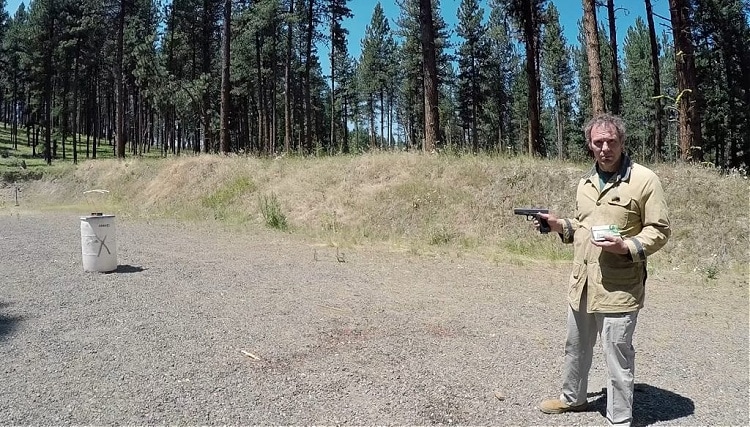
The momentum of an object describes its inertia and how difficult it will be to stop that object. In layman’s terms, this measures the level of energy transfer from a moving object to a stationary object. In even simpler terms, the momentum measures the oomph of a bullet and how hard it is going to hit.
Since momentum is a product of the mass and velocity of a moving object, the 10 mm Auto always shows higher momentum values due to the similar mass and high velocity. Again, the 10 mm is the winner in terms of impact force and stopping power.
However, the .45 ACP also has a slight advantage, which is its larger bullet diameter. This helps create a larger wound cavity and creates more damage to the tissue.
10mm vs 45 ACP: Use Cases & Effective Range
The 10 mm Auto and .45 ACP are big caliber handgun rounds that are still popular among the masses. Each of these has its own place, but it is essential to understand where one of these works the best.
Self Defense and Home Defense
The 9 mm Parabellum is undoubtedly the most popular self and home defense round in use today. The low recoil, high mag capacity, and high controllability make it a perfect choice for such situations. However, many traditionalists still prefer using the big caliber rounds for self-defense.
The 10 mm was designed for the FBI, and the .45 ACP has given decades of service in the military. Both of these are lethal rounds, but only have one condition for effective use. You must be trained really well in using these rounds because their recoil is high, and the mag capacity is low. Especially when compared to the 9 mm Parabellum.
As far as comparing these two is concerned, the .45 ACP is a better round for home defense due to low penetration. Plus, it is also better for self-defense and EDC due to its slightly lesser recoil.
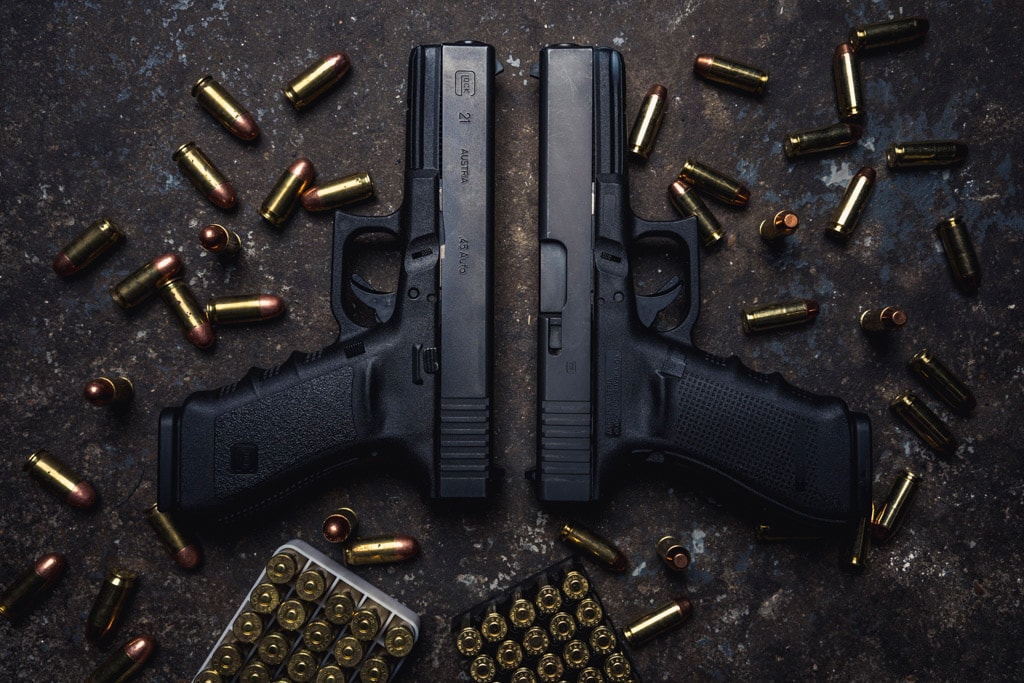
Hunting
Both these rounds are great for hunting small to medium sized game. In fact, the 10 mm Auto is widely used as a bear defense round by many hunters when roaming the bear country. It is clearly a more powerful cartridge than the .45 ACP, both on paper as well as in reality. The more energy, better velocity, and good penetration make it a comparatively superior round for hunting.
Tactical or Active Duty
The .45 ACP has served the U.S Military for more than eight decades, and it is a battle-tested and reliable round for such applications. The 10 mm Auto was exclusively designed for the LEO use, and further downsized to the .40 S&W.
I will not declare a winner from either of these rounds, because when humans are concerned, a round does not need too much power to cause lethal damage.
10mm vs 45 ACP: Costs, Availability, & Compatibility
Now let’s look at the cost, ammo availability, and other important factors related to these cartridges.
Pricey But Available
The 10 mm Auto and .45 ACP are very similar in terms of pricing. Ammo can be found for as low as $0.80 per round to as high as $3.5 per round. It does not matter which of these you choose, as far as the cost is concerned, you will have to shed equal amounts of money.
Both these rounds are also readily available on the market, especially the .45 Auto due to its long legacy. However, in some cases, like the recent Covid pandemic these rounds quickly went out of stock. So I will recommend you to either buy extra ammo or prepare a reloading setup.
Wide Range of Options
The .45 ACP has been around for more than a century now, which means that it has a ton of firearm and ammo options available on the market. The 10 mm Auto is also a popular caliber with many choices, but the .45 ACP still has an edge over it.
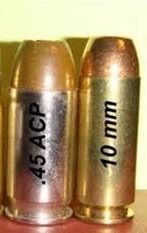
Bottom Line
The .45 ACP was developed in 1904 and was adopted as the official sidearm cartridge of the U.S Military with the Colt 1911 in 1911. The 10 mm Auto was designed in the 1980s and served the FBI for a few years before fading into obsolescence. However, it quickly came back a couple of decades ago as a reliable bear defense round.
The 10 mm Auto houses more power, better penetration, and a flatter trajectory compared to the .45 ACP. However, the latter offers subsonic capability, heavier maximum bullet weights, and a bigger wound cavity.
People Also Ask
Check out this small and comprehensive FAQ section for some quick info.
Yes, a 10 mm Auto is more powerful than the .45 ACP. It has almost 40% more energy because of the higher velocity. Plus, it also offers deeper penetration due to high sectional density. However, the .45 ACP creates a larger wound due to its bigger diameter.
The .45 ACP is comparatively cheaper than the 10 mm Auto. The reason seems to be the difference in supply and demand.
The 10 mm Auto has a higher recoil than the .45 ACP. A 180 grain 10 mm round has about 10 foot, pounds of recoil, compared to just 7 foot pounds of recoil for a .45 ACP bullet of the same weight.


